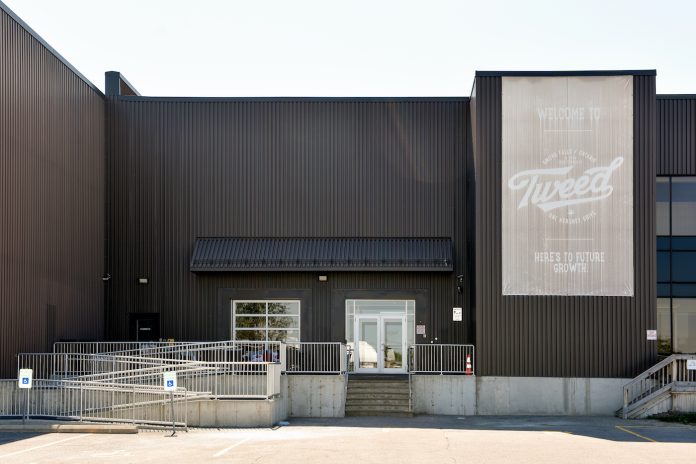SMITH FALLS, ONTARIO – Canopy Growth Corporation, one of the world’s largest cannabis cultivators and manufacturers, announced plans to lay off 35 percent of its workforce—roughly 800 jobs—in an effort to rebound from its recent CAD $266.7 million (about U.S. $196 million) net loss last quarter, following a CAD $115.5 million loss in the same quarter in 2021.
Canopy also will consolidate its once-vast cultivation division, closing its signature 1 Hershey headquarters in Smiths Falls, Ontario. The company said the facility will be repurposed for other uses.
The announcement did not come as a surprise to Canopy founder and former Chief Executive Officer Bruce Linton.
“If your sales are declining, your expenses have to decline,” he said. “If you look at the last, I believe, twelve quarters or revenues for Canopy, they have declined.”
In the past twelve months, Canopy’s year-over-year cannabis sales have fallen by 23 percent.
“This is in a market that has gone from $1.6 billion about three and a half years ago to $4.4 billion today,” Linton said. “Clearly, the problem is execution against the opportunity, which is to generate growing revenues. At the end of the day, the only way that you can sustain a business in a market that’s very busy is to have a significant first-place market share. [To do that,] you try to innovate and create what’s next, first.”
According to Linton, new additions to product categories don’t necessarily need to be revolutionary. In some cases, they simply must be new for that particular market. For example, when Canada loosened restrictions to allow for infused pre-rolls, Canadians reacted with wide-eyed enthusiasm about a product that had been available in the United States for a decade. “It was as if [pre-rolls] had never been invented in California and been around for the last ten years,” Linton said. “But when you bring these things to market and you innovate, you get market share because you become part of the conversation.”
Another way to ensure profitability, from Lintons’ point of view, is incentivizing the workforce by offering equity options as a perk. This is instead of restricted share units or deferred share units, which he said may make sense for executives but not necessarily for others.
Blaming the low-hanging fruit
A regular punching bag for complaints over lack of profitability, the illicit market still exists as a significant force in both the U.S. and Canadian landscapes. But according to Linton, placing the majority of the blame on the illicit market is an easy excuse.
“The single biggest reason [the illicit market] exists in Canada and the U.S. is because of the allocation of, effectively, taxes to various levels of government,” said Linton. “In Canada, we had a system which was supposed to be a 10-percent tax at the federal level. They said it’s $1 on a $10 sale. When the sale price, wholesale, didn’t stay at $10, they still kept the $1.”
Linton was referring to the $1 excise tax Canadian manufacturers may pay the government when they package and prepare cannabis products to sell to a licensed distributor or retailer. That excise tax originally was based on a wholesale price of CAD $10 per gram, but the wholesale price of cannabis has dropped dramatically since the tax was initiated. The $1 excise, however, remains the same.
In the U.S., with the added difficulty of not being able to deduct regular operating expenses from federal income taxes coupled with additional taxes in local jurisdictions, it’s no wonder the illicit market is maintaining ground.
Walk before you run
So, what can the industry learn from Canopy’s tribulations?
“You look at these [Canadian licensed producers], they were spending money for years, hand over fist, to expand facilities in different provinces, facilities in Africa, and facilities in Europe,” said Matt Maurer, co-chair of the Cannabis Law Group at Torkin Manes. “They always justified it as ‘well, we’re losing money now to gain market share, and it will more than pay off down the road.’ That didn’t work for most, if not all, of them who took that path.”
In Maurer’s opinion, many of the companies that are doing well today never had the ability or interest to expand on such a grand level. They focused on simply making the best cannabis products and having the best distribution they could for the market they serve, he said.
“The lesson might be, ‘You need to be cautious with how you expand and why you expand, because it could come back to bite you later on,’” he said.
He also opined that during Linton’s tenure at Canopy, innovation was a big part of the company’s mission. “They pushed the envelope with some products, and there were multiple times where they were the envy of other companies,” Maurer said.
He’s not sure how things will pan out for Canopy.
“To say you’re going to focus on products and source inputs from third parties, instead of growing yourself, you’re basically transforming, in a large way, what your company actually does. If your products now don’t sell, then you have nothing,” Maurer said. “I can understand why they’re doing it, but it also seems risky. Now you’ve got to climb to the top of the consumer loyalty mountain.”
Canopy Growth Corp. stock was trading at U.S. $2.30 on February 24, down 90 percent over the past five years. On Tuesday, the company announced an agreement to secure a senior unsecured convertible debenture of up to U.S. $150,000,000 from an institutional investor. According to Canopy Chief Financial Officer Judy Hong, the capital will allow the company to move forward with its strategic plan to fast-track entry into the U.S. market and transform its Canadian operations.











[…] States and abroad, news of a turbulent job market in the cannabis sector is not hard to find. Layoffs and market exits have become an ongoing issue affecting operators both big and small, with the 2023 […]